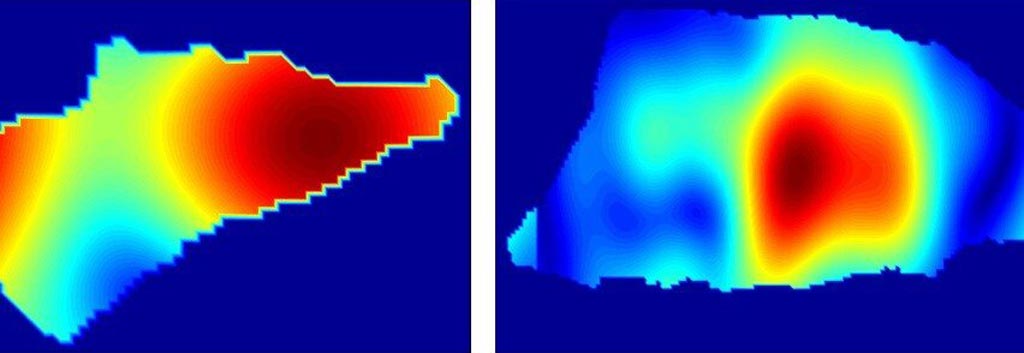Handheld Device Aids Diagnosis of Skin Cancer
By MedImaging International staff writers
Posted on 01 Jul 2019
A new study shows how ultra-high-resolution millimeter-wave imaging (UH-MMWI) can be used to detects skin lesions and determine if they are cancerous or benign.Posted on 01 Jul 2019
Developed by researchers at the Stevens Institute of Technology (Hoboken, NJ, USA) and Hackensack University Medical Center (NJ, USA), the new technology can realize three-dimensional (3D) high-contrast images of the skin by taking advantage of intrinsic dielectric contrasts between normal and malignant skin tissues. The system works in the 98 GHz bandwidth, which is also used in cellphones and airport security scanners. As cancerous tumors reflect around 40% more calibrated energy than healthy tissue, it is possible to identify diseased tissue by searching for reflectivity hotspots.

Image: Reflectivity patterns can distinguish between basal cell carcinoma (L) and squamous cell carcinoma (R) (Photo courtesy of Stevens Institute of Technology).
A programmable measurement platform automatically scan the tissues across a rectangular aperture plane, while a frequency domain imaging algorithm processes the recorded signals and generates an image of the cancerous tissue. To test the device, the researchers imaged 21 non-melanoma skin cancer specimens and compared them with histopathology. The results revealed a high correlation between MMWI and histological images, with reflectivity values statistically significant higher for cancerous areas compared to normal areas. The study was published on March 4, 2019, in IEEE Transactions on Medical Imaging.
“This technology can be used for rapidly detecting skin cancer. That's a major step forward toward our ultimate goal of developing a handheld device, which would be safe to use directly on the skin for an almost instant diagnostic reading of specific kinds of skin cancer, including lethal melanomas,” said senior author Negar Tavassolian, PhD, director of the Stevens Bio-Electromagnetics Laboratory. “We could place these devices in pharmacies, so people can get checked out and go to a doctor for a follow-up if necessary. People won't need to wait weeks to get results, and that will save lives.”
According to the researchers, it should be possible to keep manufacturing costs below USD 1,000, even at low production volumes, which is similar to the cost of current optical magnifying tools already used by dermatologists, and an order of magnitude cheaper than laser-based imaging tools, which also tend to be slower, bulkier, and less accurate than millimeter-wave scanners.
Related Links:
Stevens Institute of Technology
Hackensack University Medical Center














